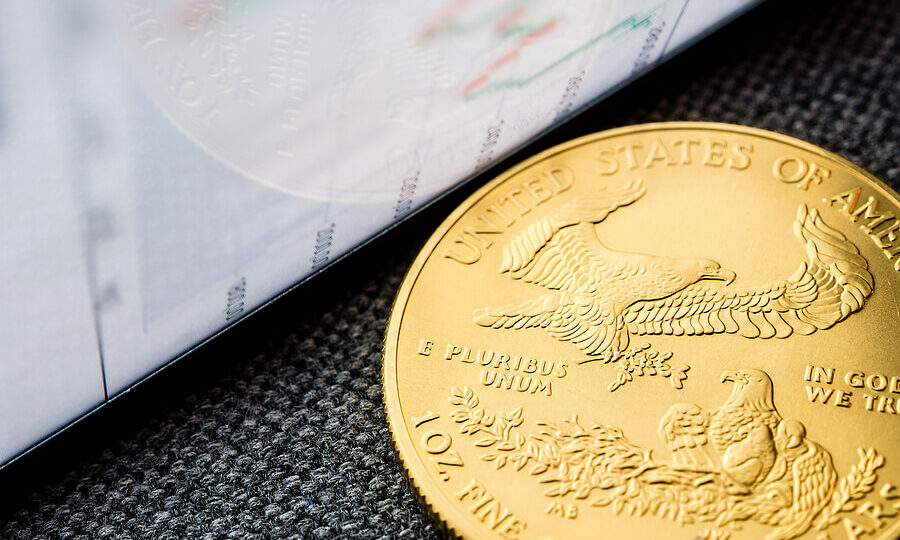Gold falls slightly on dollar strength. Inflation continues to come down, but the data shows signs of an impending wage-price spiral.
Key Takeaways:
- Gold is experiencing a slight correction after four months of strong performance.
- Inflation is still on the decline, but remains stubborn due to services inflation and rising wages. What will it take to kill the dreaded wage-price spiral?
- Rising interest rates are increasing the US debt burden. If the average interest rate on the debt rises to 5%, taxpayers would be responsible for $1.6 trillion in interest expenses every year, equating to $10,159 per taxpayer annually!
Gold Price
After soaring for four months straight, gold is finally taking a breather. The price is sitting around $1,838/oz, a consistent post-COVID choke point.
This correction is a necessary move based on gold’s strong performance and a bump in dollar strength. The chart below compares gold to the dollar currency index, which measures the strength of the US dollar against other fiat currencies.
The DXY and gold are inversely correlated.
Checking in on Inflation
Inflation is still on the decline, but came in stronger than expected last month. This is a troubling sign for investors and consumers who thought the CPI would continue its free-fall. Consumer prices rose 6.4% year-over-year: well below the high last June, but still extremely uncomfortable for monetary policymakers.
There are reasons to believe inflation will remain stubborn. Services inflation, a particularly sticky component of the CPI, is still rising. Services, which account for 57% of the CPI calculation, rose 7.6% year-over-year – the highest level since 1982.
This rise can be chalked up to labor costs. The tighter the labor market, the more upward pressure on wages. Higher wages get priced into the cost of consumer services, pushing inflation higher (the dreaded wage-price spiral).
Unfortunately, it is very difficult to stop this dynamic without “loosening the labor market” – a nice way of saying, “raise unempoyment” or “fire hundreds of thousands of workers.”
Services Inflation: Still Rising
source: tradingeconomics.com
Putting Debt in Perspective
As we all know, debt throws another wrench in the whole situation.
For the last four decades, the government stacked up massive amounts of debt with few consequences. As long as interest rates are falling (as they have been since 1981), debt is reasonably sustainable.
However, the situation gets pretty complicated when interest rates suddenly change course.
Let’s do some back-of-the-napkin math. Right now, the US national debt is about $32 trillion (and rising fast). If this debt carries an average interest rate of 1%, it’s not too bad. The taxpayers end up paying $320 billion every year on interest, a relatively small portion of the government’s total tax revenue of $4.6 trillion.
But what if the average interest rate on the national debt rises to, let’s say, 5%. All of a sudden, taxpayers are responsible for $1.6 trillion in interest expenses every year. This equates to $10,159 per taxpayer, per year! (According to the Tax Foundation, 157,494,242 people paid federal income tax in 2020).
$10,159 per taxpayer, per year.
And this is just to keep our heads above water. This does not include the costs of actually paying off the debt or paying for any of the government programs that cost so much money in the first place.
If we look at the history of government bond yields, we can see that a 5% average interest rate is not unreasonable. In 1981, the 10-year government bond yield peaked at 15%!
Paying off Debt
Governments really only have three ways to acquire the funds to pay off debt: borrowing, taxation, and printing.
Obviously, borrowing doesn’t work. Taking on debt to pay off debt doesn’t do much to reduce your total debt burden. It can work in a declining interest rate environment, but not a rising one, because every dollar we borrow gets more expensive.
Taxation doesn’t really work either. People hate taxes, and taxes would have to increase dramatically to even put a dent in the $32 trillion debt.
So that leaves one option: print. This is also not a good plan for obvious reasons, but it is the one governments have chosen time and time again.
Inflation isn’t going away anytime soon. Got gold?
Secure gold savings, without the excessive fees
Your weekly gold market commentary comes from our internal team of researchers and technical experts. Vaulted gives modern investors access to physical gold ownership at the best cost structure in the industry. With personal advising from industry experts and access to premier precious metals strategies, Vaulted is the key to life-long financial prosperity. Start protecting your portfolio today.
As always, thank you so much for reading – and happy investing!











